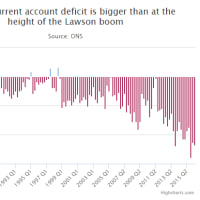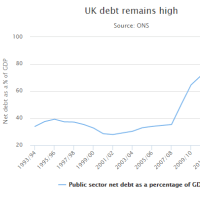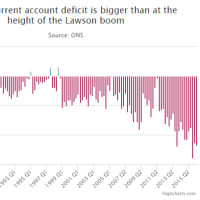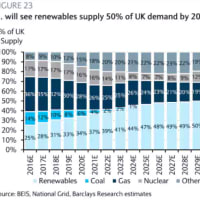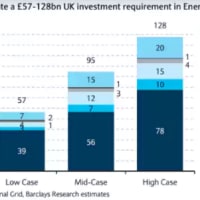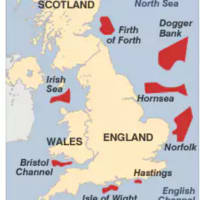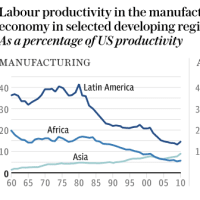Bond crash across the world as deflation trade goes horribly wrong
(デフレ・トレード大失敗で世界中で債券暴落)
By Ambrose Evans-Pritchard
Telegraph: 7:48PM BST 10 Jun 2015


(デフレ・トレード大失敗で世界中で債券暴落)
By Ambrose Evans-Pritchard
Telegraph: 7:48PM BST 10 Jun 2015
Markets ignored clear warnings in Europe and America that the money supply is catching fire, signalling a surge of inflation later this year
マーケットは、今年中に猛烈なインフレが起こることをほのめかす、欧米でマネーサプライがまずいことになりつつあるという明確なワーニングをスルーしました。
The global deflation trade is unwinding with a vengeance. Yields on 10-year Bunds blew through 1pc today, spearheading a violent repricing of credit across the world.
世界的なデフレ・トレードが猛烈な勢いで解消されつつあります。
ドイツ国債10年物は今日1%を一気呵成に突破すると、世界的な超信用調整の先陣を切りました。
The scale is starting to match the 'taper tantrum' of mid-2013 when the US Federal Reserve issued its first gentle warning that quantitative easing would not last forever, and that the long-feared inflexion point was nearing in the international monetary cycle.
量的緩和は永遠じゃないのよー、皆が前々から心配してきた世界的マネタリーサイクルの転換点は近付きつつあるのよーとFRBが最初のやんわりワーニングを出した2013年中盤の「テーパーかんしゃく玉」にスケールは匹敵しつつあります。
Paper losses over the last three months have reached $1.2 trillion. Yields have jumped by 175 basis points in Indonesia, 160 in South Africa, 150 in Turkey, 130 in Mexico, and 80 in Australia.
過去3ヶ月間の含み損は1.2兆ドルに到達。
利回りはインドネシアで175BP、南アフリカで160BP、トルコで150BP、メキシコで130BP、オーストラリアで80BPも跳ね上がりました。
The epicentre is in the eurozone as the "QE" bet goes horribly wrong. Bund yields hit 1.05pc this morning before falling back in wild trading, up 100 basis points since March. French, Italian, and Spanish yields have moved in lockstep.
震源地は「QE」ギャンブルが狂ってしまったユーロ圏。
ドイツ国債の利回りは今朝は1.05%に達し、その後、激しい取引の中で再び下落したものの、3月比+100BP。
フランス、イタリア、スペインの国債利回りも足並みを揃えました。
A parallel drama is unfolding in America where the Pimco Total Return Fund has just revealed that it slashed its holdings of US debt to 8.5pc of total assets in May, from 23.4pc a month earlier. This sort of move in the staid fixed income markets is exceedingly rare.
これと同時に、Pimco Total Return Fundが5月に米国債の保有割合を全体の23.4%(4月)から8.5%までバッサリ減らしたからと明らかにしたばっかりの米国でも劇的展開進行中。
お堅い債券市場でのこの手の動きは極めて珍しいのです。
The 10-year US Treasury yield - still the global benchmark price of money - has jumped 48 points to 2.47pc in eight trading sessions. "It is capitulation out there, and a lot of pain," said Marc Ostwald from ADM.
米国債10年物の利回り(といっても相変わらず国際的なマネーの基準価値)は8階の取引で48ポイントも急上昇して2.47%に。
「お手上げだね。しかも無茶苦茶イタイ」とADMのマルク・オストワルト氏。
The bond crash has been an accident waiting to happen for months. Money supply aggregates have been surging all this year in Europe and the US, setting a trap for a small army of hedge funds and 'prop desks' trying to squeeze a few last drops out of a spent deflation trade. "We we're too dogmatic," confessed one bond trader at RBS.
債券クラッシュは何か月も前から予期されてきた事故ですよ。
ヨーロッパと米国ではマネーサプライが年明けから急増して、賞味期限切れのデフレ・トレードから最後の一滴まで搾り取ろうと頑張るヘッジファンドや「プロップ・デスク」の一個小隊を罠にかけつつありましたから。
「俺らってあんまりにもオレサマだったわけ」とRBSの某債券トレーダーが告白しました。
Data collected by Gabriel Stein at Oxford Economics shows that 'narrow' M1 money in the eurozone has been growing at a rate of 16.2pc (annualized) over the last six months. You do not have to be monetarist expert to see the glaring anomaly.
オックスフォード・エコノミクスのガブリエル・スタイン氏がまとめたデータからは、ユーロ圏のM1の伸び率が過去6か月間16.2%(年率)にもなっていたことがわかります。
マネタリスト専門家じゃなくても強烈なアノマリーだってわかるでしょ。
Broader M3 money has been rising at an 8.4pc rate on the same measure, a pace not seen since 2008.
また同時期のM3の伸び率は8.4%と、2008年来お初なペースでした。
Economic historians will one day ask how it was possible for €2 trillion of eurozone bonds - a third of the government bond market - to have been trading at negative yields in the early spring of 2015 even as the reflation hammer was already coming down with crushing force.
経済歴史学者はいつの日かこう問うことでありましょう。
リフレ・ハンマーがもう力一杯振り下ろされつつあったのに、2015年の春に3兆ユーロものユーロ債(国債市場の3分の1)がマイナス金利で取り引きされてたとか、一体全体何でよって。
"It was the greater fool theory. They always thought there would be some other sucker to buy at an even higher price. Now we are returning to sanity," said Mr Stein.
「グレーター・フール・セオリーだよ。あいつら、俺よりもっと高い値段で買うバヤカロウがいる、っていつも思ってたんだ。今や正気に戻りつつあるわけで…」とスタイン氏。
M3 growth in the US has been running at an 8pc rate this year, roughly in line with post-war averages. The growth scare earlier this year has subsided, as was to be expected from the monetary data.
米国でのM3の伸びは今年に入って8%のスピードで、概ね戦後平均水準です。
今年先の経済成長頓挫パニックも落ち着き、マネタリー・データからそう予想された通りですね。
The economy has weathered the strong dollar shock and seems to have shaken off a four-month mystery malaise. It created 280,000 jobs in May. Bank of America's GDP 'tracker' is running at a 2.9pc rate this quarter.
米経済は超米ドル高ショックを乗り越えたようでもあり、また、4ヶ月に亘る謎の沈滞も振り切ったようです。
5月には28万人分の雇用が生まれました。
バンク・オブ・アメリカのGDP「トラッカー」は今期は2.9%をつけています。
Capital Economics calculates that hourly earnings have been rising at a rate of 2.9pc over the last three months, the fastest since the six-year expansion began.
キャピタル・エコノミクスの試算だと、この3ヶ月間、時給の伸び率は2.9%だったとかで、6年間の経済成長が始まって以来最速です。
Bond vigilantes - supposed to have a sixth sense for incipient inflation, their nemesis - strangely missed this money surge on both sides of the Atlantic. Yet M1 is typically a six-month leading indicator for the economy, and M3 leads by a year or so. The monetary mechanisms may be damaged but it would be courting fate to assume that they have broken down altogether.
債券自警団(ってホントは天敵であるインフレの気配を察知する第六感があるんじゃなかったのかと)は、大西洋の両岸でのマネーの爆増を、不思議なことに、見逃しました。
でもM1は大体6か月先行指標で、M3は1年くらい。
マネタリー・メカニズムはダメージ食らってるかもしれないけど、完全にぶっ壊れたかもって思うのは縁起悪いでしょうし。
Jefferies is pencilling in a headline rate of 3pc by the fourth quarter as higher oil prices feed through. If they are right, we will be facing a radically different economic landscape within six months.
ジェフリーズは、石油価格上昇が浸透して第4四半期までに消費者物価指数は3%になると見込んでいます。
彼らが正解なら、僕らは6か月以内に全く違う経済展望に直面することになりますね。
This has plainly been a bond market bubble, one that is unwinding with particular ferocity because new regulations have driven market-makers out of the business and caused liquidity to evaporate. Laurent Crosnier from Amundi puts it pithily: "rather than yield at no risk, bonds have been offering risk at no yield."
これは一目瞭然の債券市場バブルでして、新しい規制がマーケット・メーカーを商売あがったりにして流動性を蒸発させたおかげで特殊な勢いでもって解消中です。
アムンディのLaurent Crosnier氏はさくっとこう言いました。
「ノー・リスクのイールドじゃなくて、ノー・イールドのリスクを債券はオファーしてるのね」
Funds thought they were on to a one-way bet as the European Central Bank launched quantitative easing, buying €60bn of eurozone bonds each month at a time when fiscal retrenchment was causing fresh supply to dry up. They expected Bunds to vanish from the market altogether as Berlin increases its budget surplus to €18bn this year and retires debt.
ファンドは、ECBが量的緩和を開始して、財政引き締めで新規供給が枯渇している時に毎月ユーロ債を600億ユーロずつ買うんだから、絶対負けるわけないと思ってたんですな。
で、ドイツ政府が今年の財政黒字を180億ユーロに増やして国債を引き上げるんだから、ドイツ国債は市場から全くなくなるぞ、と思ってたんですね。
Instead they have discovered that the reflationary lift from QE overwhelms the 'scarcity effect' on bonds. Contrary to mythology - and a lot of muddled statements by central bankers who ought to know better - QE does not achieve its results by driving down yields, at least not if conducted properly and if assets are purchased from outside the banking system. It works through money creation. This in turn lifts yields.
ところがどっこい、QEのリフレ・リフトは債券「不足効果」を圧倒しちゃったと。
神話(とか、もっとよくわかってなきゃおかしい中銀マンの寝言の山)とは逆に、QEって利回り下げたところで結果を出せないんですよ。
少なくとも適切に実施されてなかったり、資産が銀行システム外から購入されてないなら、出せないの。
貨幣創出によって機能するの。
で、それが利回りを押し上げるの。
The ECB's Mario Draghi has achieved his objective. He has (for now) defeated deflation in Europe. After six years of fiscal overkill, monetary contraction, and an economic depression, the region is coming back to life.
マリオ・ドラギECB総裁は目標を達成しました。
総裁は(今のところ)ヨーロッパのデフレを殲滅しました。
6年間に亘るやり過ぎ緊縮財政、金融引き締め、不況の末、この地域は息を吹き返しつつあります。
How this now unfolds for the world as a whole depends on the pace of tightening by the Fed. Futures contracts are still not pricing in a full rate rise in September. They are strangely disregarding the message from the Fed's own voting committee - the so-called 'dots' - that further rises will follow relatively soon and hard.
これが今、全世界にとってどのように展開するのかはFRBの引き締めペース次第です。
先物は相変わらず9月に全面引き上げを折り込んでいません。
比較的早い時期に厳しい追加上昇があるだろう、というFRBの議決委員会(dots)のメッセージを奇妙にスルーしています。
The Fed is implicitly forecasting rates of 1.875pc by the end of next year. Markets are betting on 1.25pc, brazenly defying the rate-setters in a strange game of chicken.
FRBは来年末までに金利は1.875%になるよ、と言外に予測しているわけです。
マーケットは1.25%だと賭けて、おかしなチキンゲームの中で金利決定者に厚かましく楯突いています。
The International Monetary Fund warned in April that this mispricing is dangerous, fearing a "cascade of disruptive adjustments" once the Fed actually pulls the trigger.
IMFは4月に、FRBが本気になったら「次々とヤバい調整がやってくる」ことを危惧して、このミスプライスは危険だとワーニングしました。
Nobody knows what will happen when the spigot of cheap dollar liquidity is actually turned off. Dollar debts outside US jurisdiction have ballooned from $2 trillion to $9 trillion in fifteen years, leaving the world more dollarised and more vulnerable to Fed action than at any time since the fixed exchange system of the Gold Standard.
やっすい米ドル流動性の蛇口が締められちゃったらどうなるか、なんて誰にもわかりませんよ。
米国外の米ドル建て債務の残高は15年間で2兆ドルから9兆ドルまで爆増して、金本位制時代からこっち前例がないぐらい、世界はどんどん米ドルになって、どんどんFRBの動きに弱くなっちゃいましたから。
Total debt has risen by 30 percentage points to a record 275pc of GDP in the developed world since the Lehman crisis, and by 35 points to a record 180pc in emerging markets.
GDPに対する総債務の割合はリーマン危機以降に先進国では30%増えて275%の新記録だし、新興国でも35%増えて史上最高の180%達成ですよ。
The pathologies of "secular stagnation" are still with us. China is still flooding the world with excess manufacturing capacity. The global savings rate is still at an all-time high of 26pc of GDP, implying more of the same savings glut and the same debilitating lack of demand that lies behind the Long Slump.
「長期不況」の症状が消えきってません。
中国は未だに世界中を過剰生産性でジャブジャブにしてるし。
世界の貯蓄率は未だに史上最高の26%、つまり長期不況の背景にあるお馴染みの貯蓄過剰とお馴染みの衰弱性需要不足が悪化してるってことね。
As Stephen King from HSBC wrote in a poignant report - "The World Economy's Titanic Problem"- we have used up almost all our fiscal and monetary ammunition, and may face the next global economic downturn with no lifeboats whenever it comes.
HSBCのスティーヴン・キング氏が厳しいレポート(『世界経済のタイタニック的問題』)に書いてた通りなのね。
僕らは財政と金融の弾をほぼ撃ちつくしちゃってて、次の世界的な景気後退には、それがいつ来ようが関係なく、救命ボートなしの状態で挑まなきゃならないかもしれない、ってことですよ。
The US is perhaps strong enough to withstand the rigours of monetary tightening. It is less clear whether others are so resilient. The risk is that rising borrowing costs in the US will set off a worldwide margin call on dollar debtors - or a "super taper tantrum" as the IMF calls it - that short-circuits the fragile global recovery and ultimately ricochets back into the US itself. In the end it could tip us all back into deflation.
米国には多分、金融引き締めのパワーにも負けないほどの体力があるんでしょうね。
他の国もそれほどタフかというと、そっちはよくわかりません。
危険なのは、米国での借入金利の上昇が、脆弱な世界的景気回復をショートさせて最終的には米国に跳ね返ってくる、世界的な米ドル債務者に対する追証発生を引き起こすことです(IMFは「スーパー・テーパーかんしゃく玉」と呼んでます)。
最終的には僕ら全員、デフレに逆戻りですよ。
"We at the Fed take the potential international implications of our policies seriously," said Bill Dudley, head of the New York Fed.
ニューヨーク連銀のビル・ダドリー総裁は「僕らFRBの中の人は僕らの政策の潜在的な国際的意味合いを真剣に捉えてるから」と仰ってます。
Yet in the same speech to a Bloomberg forum six weeks ago he also let slip that interest rates should naturally be 3.5pc once inflation returns to 2pc, a thought worth pondering.
でも、6週間前にブルームバーグ・フォーラムで行った同じスピーチの中で、こうもペロっと言っちゃったんですよね。
インフレ率が2%に戻ったら金利は自然に3.5%になるはずだよね、って。
一考に値しますな。
Furthermore, he hinted that Fed may opt for the fast tightening cycle of the mid-1990s, an episode that caught markets badly off guard and led to the East Asia crisis and Russia's default.
それに総裁は
FRBは1990年代中盤の高速引き締めサイクルを選んじゃうかも、ともほのめかしています。
あれはマーケットに酷い不意討ちを食らわせた上に、東アジア金融危機とロシアのデフォルトを引き起こした事件ですよ。
The bond ructions this week are an early warning that it will not be easy to wean the world off six years of zero rates across the G10, and off dollar largesse on a scale never seen before. Central banks have no safe margin for error.
今週の債券騒動は、G10全域がゼロ金利なんて6年間と、前代未聞のスケールで起こった米ドル・ジャブジャブ状態から世界を引き離すのは、そう容易じゃないぞっていう早期警報ですね。
















